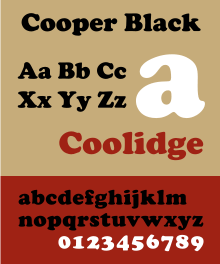Cooper Black
 | |
| Category | Serif; display type |
|---|---|
| Designer(s) | Oswald Bruce Cooper |
| Foundry | Barnhart Brothers & Spindler |
| Date released | 1922 |
| Re-issuing foundries | American Type Founders, Wordshape |
Cooper Black is an ultra-bold serif typeface intended for display use that was designed by Oswald Bruce Cooper and released by the Barnhart Brothers & Spindler type foundry in 1922.[1] The typeface was drawn as an extra-bold weight of Cooper's "Cooper Old Style" family. It rapidly became a standard typeface and was licensed by American Type Founders and also copied by many other manufacturers of printing systems.[2][3][4]
Cooper Black followed on from Cooper's career as a lettering artist in Chicago and the Midwest of America in the 1920s.[3][5][6] Cooper Black was advertised as being "for far-sighted printers with near-sighted customers", as well as "the Black Menace" by detractors.[7] While very bold, Cooper Black is based on traditional "old-style" serif lettering, rather than the hard-edged "fat face" fonts popular in the nineteenth century, giving it a soft, 'muddy' appearance, with relatively low contrast between thick and thin strokes.[8][9][10][8][11]
Cooper Hilite
.jpg)
Cooper Hilite is a version of Cooper Black originally designed by painting white relief impressions into a printed proof of Cooper Black.[3] It has been digitised by ParaType and Wordshape.[12]
Imitations and variants

Cooper Black was immediately popular and spawned imitations, including Goudy Heavy Face from Frederic Goudy, Ludlow Black and Pabst Extra Bold.[13][14]
Many unusual versions of Cooper were created in the phototypesetting period of the 1960s and 1970s, a period of explosion in production of display faces. These included "Ziptop Cooper Black" from Photo Lettering Inc., a version with the top bolder than the bottom, and other distorted variants.[15]
Many digitisations of Cooper Black exist from companies including Bitstream, Adobe and others.[8] Soap, designed by Ray Larabie of Typodermic, is a uni-case variant.[16] A version from URW, which does not include an italic, is bundled with many Microsoft products.[17] Cooper Old Style has been digitised by URW.[18]
See also
References
- ↑ "Cooper Black". Fonts in Use. Retrieved 12 September 2017.
- ↑ Neil Macmillan (2006). An A-Z of Type Designers. Yale University Press. p. 69. ISBN 0-300-11151-7.
- 1 2 3 Heller, Steven. "Telling and selling". Eye. Retrieved 12 September 2017.
- ↑ Eisinger, Dale. "The Complete History of the Cooper Black Font in Hip-Hop". Complex. Retrieved 12 September 2017.
- ↑ Shinn, Nick. "The Golden Age of Hand Lettering in American Advertising". Type Culture. Retrieved 1 April 2017.
- ↑ Middleton, R. Hunter (1937). Chicago Letter Founding. Chicago: Black Cat Press. pp. 22–23. Retrieved 9 July 2017.
- ↑ Steven Heller (6 May 2014). Design Literacy: Understanding Graphic Design. Allworth Press. pp. 217–9. ISBN 978-1-62153-413-6.
- 1 2 3 Heck, Bethany. "Cooper". Font Review Journal. Retrieved 12 September 2017.
- ↑ Phinney, Thomas. "Fat faces". Graphic Design and Publishing Centre. Retrieved 10 August 2015.
- ↑ Kennard, Jennifer. "The Story of Our Friend, the Fat Face". Fonts in Use. Retrieved 11 August 2015.
- ↑ Bramley, Ellie Violet. "Just my type: how Cooper Black became 2017's most fashionable font". The Guardian. Retrieved 12 September 2017.
- ↑ "Cooper Hilite". Fonts in Use. Retrieved 12 September 2017.
- ↑ Tracy, Walter. Letters of Credit. pp. 130–1.
- ↑ http://www.myfonts.com/fonts/bitstream/goudy-heavyface/
- ↑ Coles, Stephen. "Ziptop Cooper Black". Fonts in Use. Retrieved 12 September 2017.
- ↑ http://www.typodermic.com/46.html
- ↑ "Cooper Black". Microsoft. Retrieved 12 September 2017.
- ↑ "Cooper Old Style". MyFonts. URW. Retrieved 18 November 2017.
- Allan Haley. Typographic Milestones. John Wiley and Sons: September 1992. ISBN 978-0-471-28894-7.
- Blackwell, Lewis. 20th Century Type. Yale University Press: 2004. ISBN 0-300-10073-6.
- Fiedl, Frederich, Nicholas Ott and Bernard Stein. Typography: An Encyclopedic Survey of Type Design and Techniques Through History. Black Dog & Leventhal: 1998. ISBN 1-57912-023-7.
- Jaspert, W. Pincus, W. Turner Berry and A.F. Johnson. The Encyclopedia of Type Faces. Blandford Press Lts.: 1953, 1983. ISBN 0-7137-1347-X.
- Macmillan, Neil. An A–Z of Type Designers. Yale University Press: 2006. ISBN 0-300-11151-7.